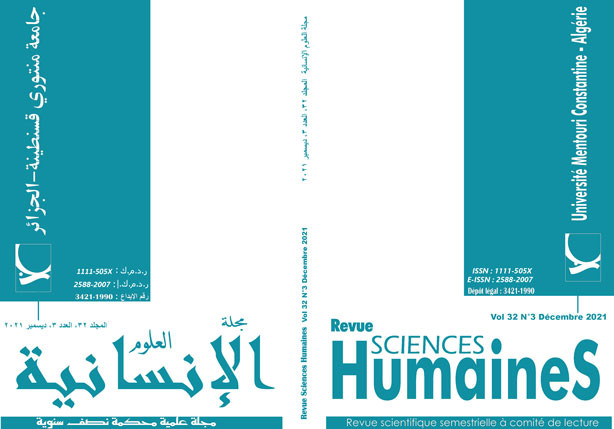LE E-LEARNING A L’UNIVERSITE DURANT LA PANDEMIE COVID-19, ENTRE PERSPECTIVES ET REALITE DU TERRAIN
الكلمات المفتاحية:
التعليم الالكتروني، الازمة الصحية، الوسائل الرقمية، ممارسات التدريس، التعليمية الذاتيةالملخص
مع الأزمة الصحية كوفيد 19، أصبح التعليم الإلكتروني محط اهتمام مختلف المؤسسات التعليمية ، ولا سيما الجامعة. وفي الجزائر ، اختارت وزارة التعليم العالي والبحث العلمي ، شأنها شأن العديد من بلدان العالم ، التعليم بالتناوب ، خلال السنة الدراسية 2020-2021 لمكافحة انتشار الفيروس. في هذا السياق ، يجري التدريس في فترتين، هما فترة التعليم حضوريا ، تليها فترة التعلم عن بعد. ولضمان الدعم التربوي للمتعلمين خلال مرحلة التعلم عن بعد ، أوصي بأن يقدم المدرسون دورات على الإنترنت عن طريق منصة مودل أو غيرها من الوسائل الرقمية. من خلال هذه المساهمة ، نعتزم تسليط الضوء على مختلف استراتيجيات التعليم/التعلم الناشئة عن هذا الأسلوب في التدريس. نتساءل أيضا عن فعاليتها ونأمل أن نقترح اجراءات تسهم في تحسينها.
التنزيلات
المراجع
. Barbot, Marie-José, Barbot, M.-J. (2003). "Médiatisation dans l'enseignement : vers un nouveau paradigme éducatif ?", Apprentissage des langues et systèmes d'information et de communication, Volume : 06, numéro : 1, année, pp. 175-189.
. Charlier, Beradette, Deschryver, Nathalie. & Peraya, Daniel. (2006). "Apprendre en présence et à distance – Une définition des dispositifs hybrides". Distances et savoirs, vol. 4, n° 4. pp. 469 496
. Charlier, Beradette, Deschryver, Nathalie. & Peraya, Daniel. (2014). "Une première approche de l’hybridation". Éducation et Formation, n° e-301. pp. 15 34.
. Coswatte, Sandra, (2014). Updated E-Learning Definition. Conlsulté le 01-04-2021: https://onlinelearningconsortium.org/updated-e-learning-definitions/
. Holec, Henri. « orientations pédagogiques fondamentales ». in Holec, H. & Huttun, Irma. (dir.). L’autonomie de l’apprenant en langues vivantes. Recherche et développement. Strasburg : Conseil de l’Europe. pp. 13-22.
. Peraya, Daniel. (2005). « La formation à distance : un dispositif de formation et de communication médiatisée. Une approche des processus de médiatisation et de médiation, TICE et de développement ». Technologies Développement Recherche. Visité le 16-02-2021 : https://archive-ouverte.unige.ch/unige:17647
. Puren, Christian. (2020). Ess ai de problématisation et de modélisation de l’ « enseignement à distance » en didactique scolaire des langues-cultures : pour une ingénierie de l’hybridation. Consulté le 30-08-2021. file:///C:/Users/mscom/AppData/Local/Temp/PUREN_2020e_Didactique%20hybridation.pdf
. Ryan, M. Richard & Deci, Edward L. (2000). “Intrinsic and extrinsic motivations: classic definitions and new directions”. Contemporary education psychology. Volume: 25, numéro 1. pp. 54-67.
. Sener, John (2015). Updated E-Learning definition. Conlsulté le 01-04-2021: https://onlinelearningconsortium.org/updated-e-learning-definitions-2/
التنزيلات
منشور
إصدار
القسم
الرخصة

هذا العمل مرخص بموجب Creative Commons Attribution-NonCommercial-ShareAlike 4.0 International License.












